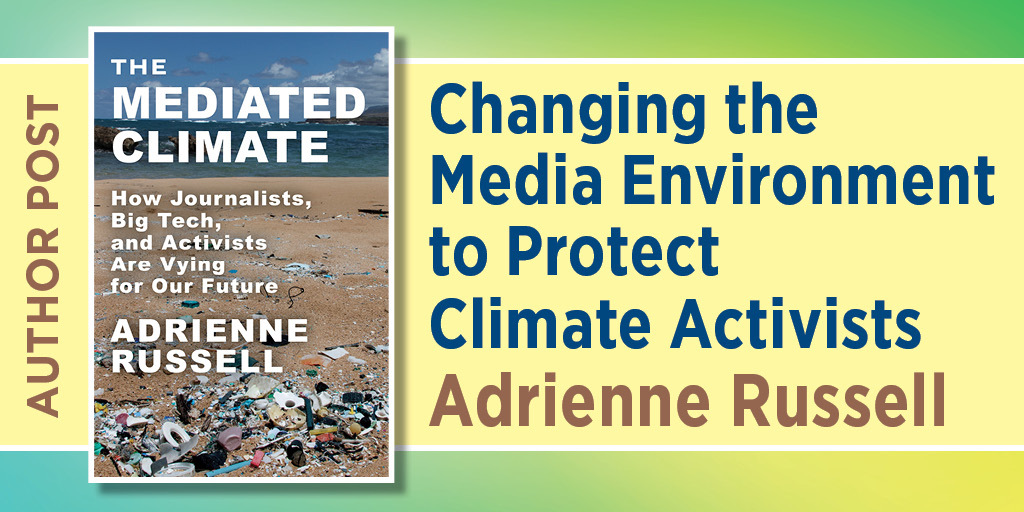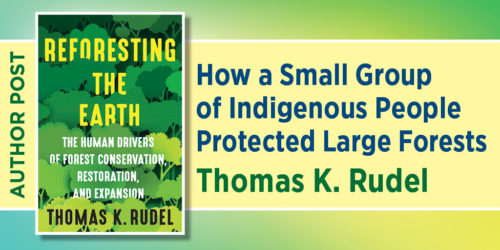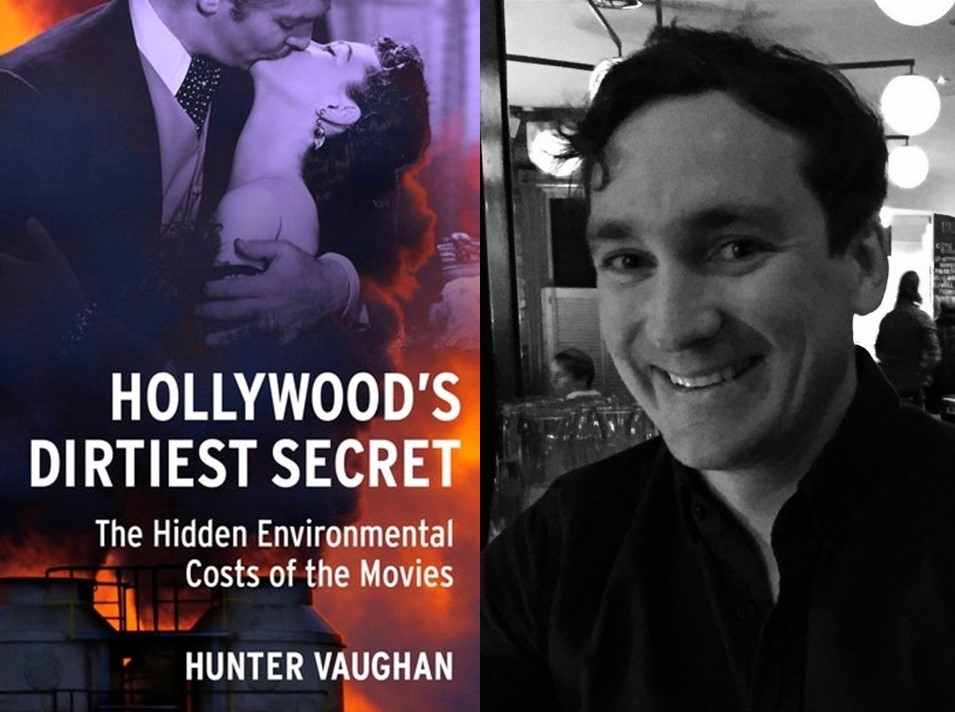Changing the Media Environment to Protect Climate Activists
Adrienne Russell

Activism serves as an essential channel of communication from the public to policy makers, corporations, and other powerful actors. It is precisely because of its essential role in governance (and even capitalist arrangements, such as so-called voting with your pocketbook) that protest is a protected activity in democratic societies. But today activism, especially climate activism, is under attack on all sides.
A February report by the UN special rapporteur on environmental defenders Michael Forst asserts that “the repression that environmental activists who use peaceful civil disobedience are currently facing in Europe is a major threat to democracy and human rights.” And in the United States, the crackdown on activists opposed, on social and environmental grounds, to the construction of the $90 million “Cop City” Atlanta Public Safety Training Center in Georgia is making headlines. Protestors at the site have been arrested in droves, and many have been charged under Georgia’s domestic terrorism laws, a charge that carries a sentence of up to thirty-five years in prison.
In The Mediated Climate, I document many challenges faced by environmental activists. When protests heated up, the groups I studied often faced abuse by law enforcement. This was especially the case with the Indigenous-led movement to stop the Dakota Access Pipeline. Police and private security officers used rubber bullets, water cannons, tear gas, and attack dogs on demonstrators. To conceal their rough tactics, they also convinced the Federal Aviation Administration to set up an ad hoc temporary flight restriction over a four-mile radius surrounding the Standing Rock protests, to keep activists from documenting the scene with drone cameras.
But the more quotidian injustices against activists occur as they navigate the media environment. Online and in legacy media, activists face harassment, threats, and misrepresentation, among other efforts to silence, intimidate, and belittle them.
The Seattle-based activist Jamie Margolin, for example, described to me the various types of online abuse she has faces: “Yeah, I get hate all the time. I get people sliding into my DMs telling me things. Some people will call me antigay slurs and stuff because I’m very openly out. Some people will say weird and rapey things to me.” Greta Thunberg famously received similarly bad treatment. Politicians and columnists have harped on Thunberg, describing her as a “hysterical teenager” in need of a “spanking.” Others have said she ought to be “burnt at the stake” and circulated images of a sex doll that resembles Thunberg and purportedly “speaks” using recordings of her voice. A cartoon circulates online that appears to depict her being sexually assaulted.
Activists are forced to spend an enormous amount of time and effort dodging attacks, correcting misinformation, and developing strategies to protect themselves from harm and misrepresentation in this unjust media environment.
Such attacks are appalling if not surprising symptoms of misogyny and bigotry. But they are also meant to hinder the work of building networks of solidarity, creating alternative content, garnering mainstream attention, and mobilizing. Activists are forced to spend an enormous amount of time and effort dodging attacks, correcting misinformation, and developing strategies to protect themselves from harm and misrepresentation in this unjust media environment.
High-profile examples include Greta Thunberg’s public sparring with Donald Trump. In one incident in 2019, Donald Trump tweeted “So ridiculous. Greta must work on her Anger Management problem, then go to a good old-fashioned movie with a friend! Chill Greta, Chill!” Following the president’s tweet, Thunberg updated her Twitter bio to reflect Trump’s comments: “A teenager working on her anger management problem. Currently chilling and watching a good old-fashioned movie with a friend.” Her response not only demonstrated her savvy ability to troll-back at Trump but also garnered attention from mainstream media, which shed a brief light on the poor treatment she endures, often by public officials. In another case, Luisa Neubauer, a prominent organizer of Germany’s Fridays for the Future movement, won a court case against a right-wing blogger for a Facebook post that attempted to sexually humiliate her. She also sued Facebook and won, forcing them to turn over the blogger’s data.
The efforts activists make to overcome the toxic media environment underscore the fact that media justice is a central part of the fight for climate (and social) justice. Climate activists must contend with injustice—in the form of surveillance, harassment, invisibility, misrepresentation—as they go about their business of trying to save the planet. And so, by default, their work ends up including fights for media justice.
The Mediated Climate suggests some ways we could protect and support activists by demanding more of our media environment:
Stop protecting abusers and detractors. We can stop privileging individual and corporate over collective interests. The logic that shapes internet policy and content-moderation practices champions the rights of individuals to speak (no matter how loud or toxic their message) over the collective rights that would ensure our right to hear one another and gain the benefit of a richer diversity of voices. This conception of freedom of speech needs to be updated. In the words of Whitney Phillips and Ryan Milner in You Are Here: “It’s the difference between asserting that an individual has the right to spew whatever poison they want without restraint and asserting that those within the collective have the right not to be poisoned.”
Hold companies responsible for the content they host. We can levy steep fines on bad actors, as the European Union Digital Services Act is doing. And we must demand interoperability—the ability of different systems to connect and communicate—so that when we approve of what a platform or application is doing, we can take all of our connections and content with us when we leave.
Start recognizing that the people on the front line of demanding climate action are the heart of democracy. We must stop criminalizing climate activism and resist the language of criminalization prompted by some states. States are weaponizing language by labeling activists “terrorists,” portraying them as threats to public safety—but journalists must not follow suit. Leading climate journalists have already moved away from reporters’ tendency to frame protests as deviant. As Forst points out, “The only legitimate response to peaceful environmental activism and civil disobedience at this point is that the authorities, the media, and the public realize how essential it is for us all to listen to what environmental defenders have to say.”
The idea that we need climate action now is not a radical idea. In fact, it is more mainstream than most of us realize. A study released in February in the journal Nature Climate Change found that, across the globe, there is near-universal public support for climate action, yet also near-universal underestimation of others’ support and commitment to climate issues. That is, people care about the climate crisis and are willing to do something about it. They just don’t think others feel the same. These findings resonate with other leading research on increasing support for climate action the world over.
Climate activists have already shifted the Overton window, or the range of possible and acceptable policy. People are ready and willing make changes in response to our climate circumstances. Let’s not let law enforcement or the distorted media environment convince us otherwise.
Adrienne Russell is Mary Laird Wood Professor and codirector of the Center for Journalism, Media, and Democracy in the Department of Communication at the University of Washington and the author of The Mediated Climate: How Journalists, Big Tech, and Activists Are Vying for Our Future.








